University Nursing Case Study: Analysis of Patient Care and Errors
VerifiedAdded on 2022/10/12
|7
|1765
|457
Case Study
AI Summary
This case study analyzes a nursing incident involving an 81-year-old patient admitted to a rural hospital with shortness of breath. The case highlights a series of professional errors by a Registered Nurse (RN), including delayed medical intervention, lack of proper documentation, and poor communication skills. The RN failed to promptly address the patient's deteriorating condition, leading to a delay in necessary medical interventions and ultimately, the patient's death due to septicaemia. The analysis identifies key contributory factors such as the RN's delay in action, failure to understand the emergency situation, and inadequate documentation of the patient's health parameters. The study emphasizes the importance of adhering to the Nursing and Midwifery Board of Australia (NMBA) guidelines, utilizing critical thinking, and effective communication to ensure patient safety. The document also discusses the implications for future practice, emphasizing the importance of promptness, preparedness, and the use of critical thinking skills in nursing practice to prevent similar incidents.
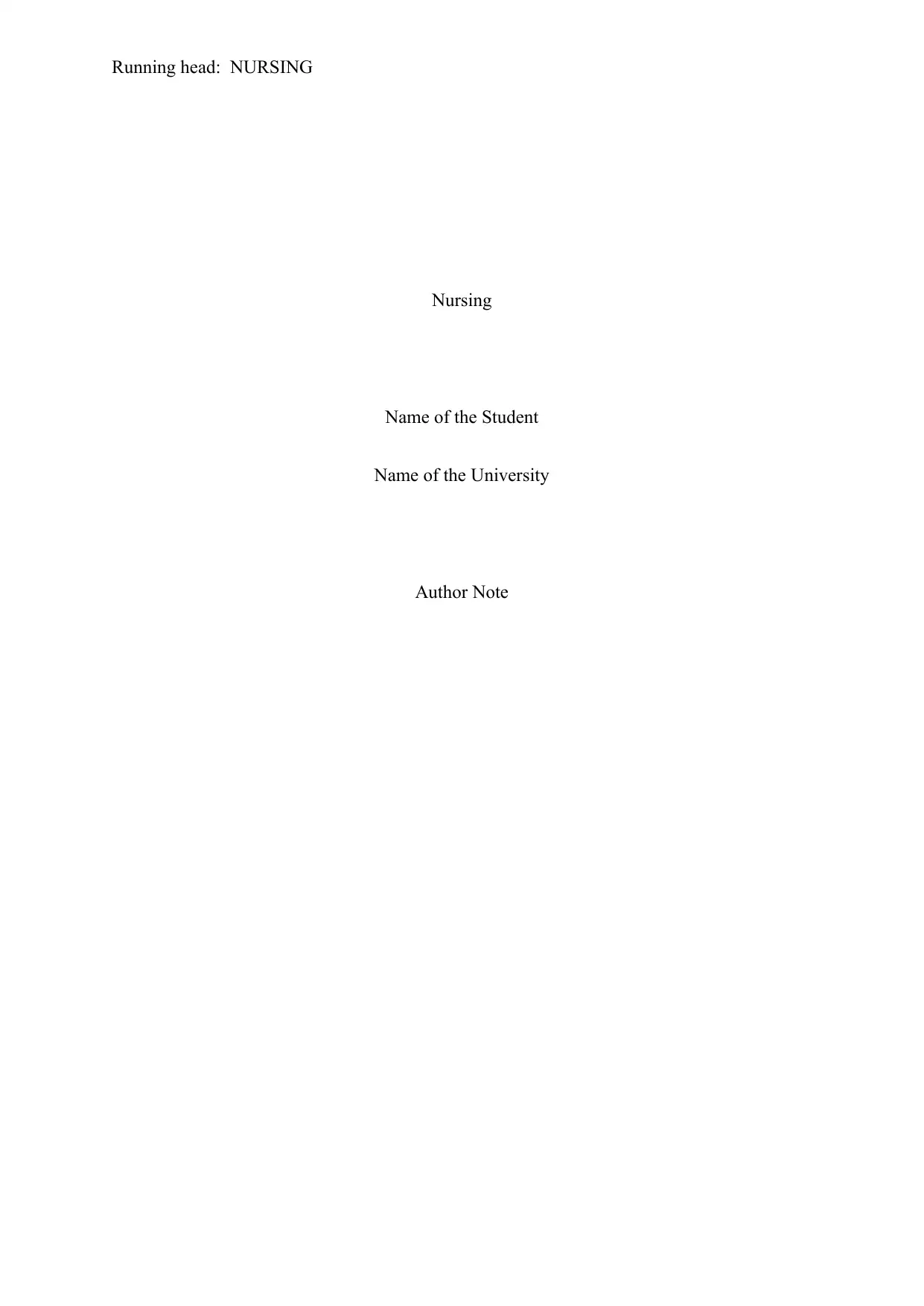
Running head: NURSING
Nursing
Name of the Student
Name of the University
Author Note
Nursing
Name of the Student
Name of the University
Author Note
Paraphrase This Document
Need a fresh take? Get an instant paraphrase of this document with our AI Paraphraser
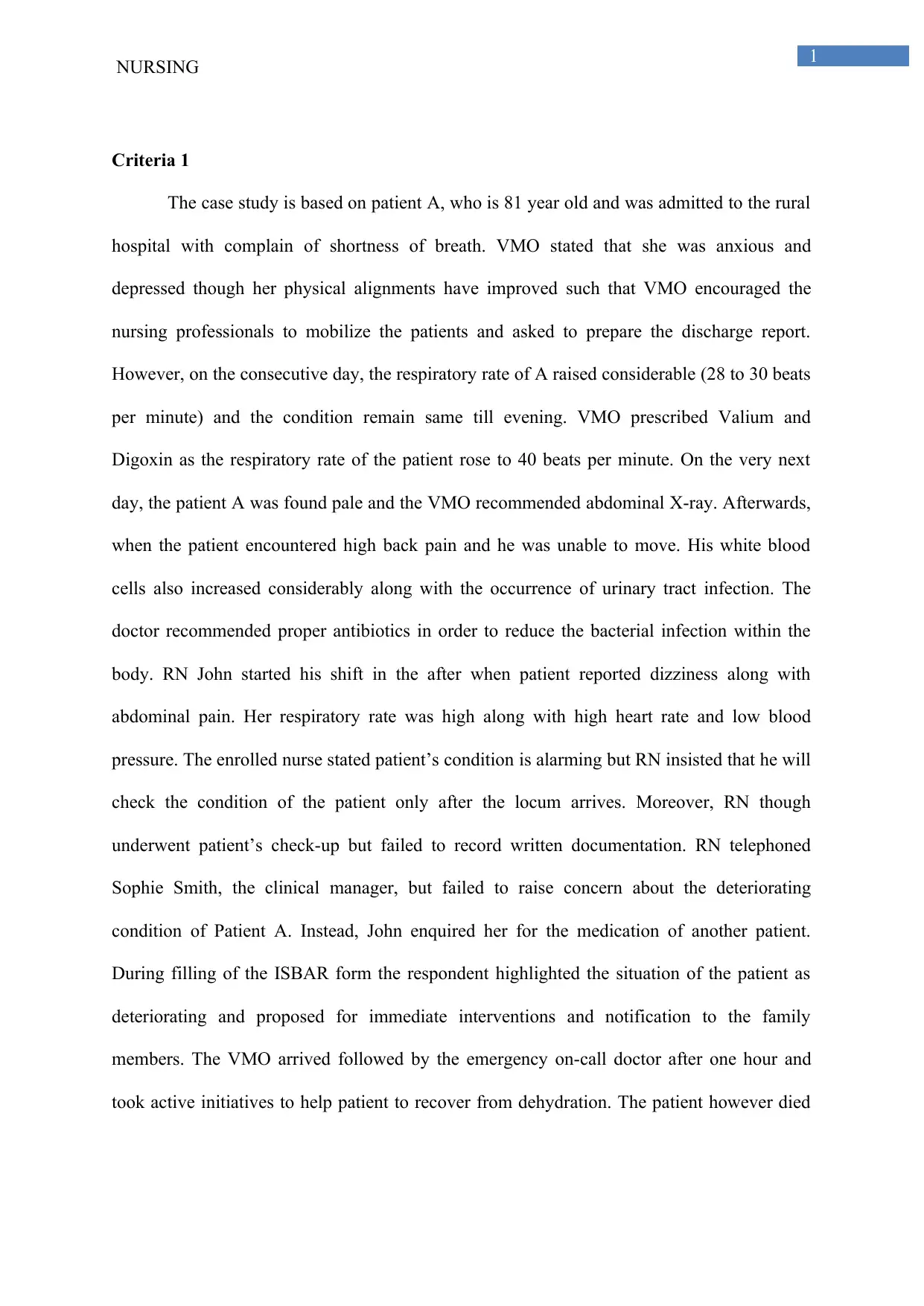
1
NURSING
Criteria 1
The case study is based on patient A, who is 81 year old and was admitted to the rural
hospital with complain of shortness of breath. VMO stated that she was anxious and
depressed though her physical alignments have improved such that VMO encouraged the
nursing professionals to mobilize the patients and asked to prepare the discharge report.
However, on the consecutive day, the respiratory rate of A raised considerable (28 to 30 beats
per minute) and the condition remain same till evening. VMO prescribed Valium and
Digoxin as the respiratory rate of the patient rose to 40 beats per minute. On the very next
day, the patient A was found pale and the VMO recommended abdominal X-ray. Afterwards,
when the patient encountered high back pain and he was unable to move. His white blood
cells also increased considerably along with the occurrence of urinary tract infection. The
doctor recommended proper antibiotics in order to reduce the bacterial infection within the
body. RN John started his shift in the after when patient reported dizziness along with
abdominal pain. Her respiratory rate was high along with high heart rate and low blood
pressure. The enrolled nurse stated patient’s condition is alarming but RN insisted that he will
check the condition of the patient only after the locum arrives. Moreover, RN though
underwent patient’s check-up but failed to record written documentation. RN telephoned
Sophie Smith, the clinical manager, but failed to raise concern about the deteriorating
condition of Patient A. Instead, John enquired her for the medication of another patient.
During filling of the ISBAR form the respondent highlighted the situation of the patient as
deteriorating and proposed for immediate interventions and notification to the family
members. The VMO arrived followed by the emergency on-call doctor after one hour and
took active initiatives to help patient to recover from dehydration. The patient however died
NURSING
Criteria 1
The case study is based on patient A, who is 81 year old and was admitted to the rural
hospital with complain of shortness of breath. VMO stated that she was anxious and
depressed though her physical alignments have improved such that VMO encouraged the
nursing professionals to mobilize the patients and asked to prepare the discharge report.
However, on the consecutive day, the respiratory rate of A raised considerable (28 to 30 beats
per minute) and the condition remain same till evening. VMO prescribed Valium and
Digoxin as the respiratory rate of the patient rose to 40 beats per minute. On the very next
day, the patient A was found pale and the VMO recommended abdominal X-ray. Afterwards,
when the patient encountered high back pain and he was unable to move. His white blood
cells also increased considerably along with the occurrence of urinary tract infection. The
doctor recommended proper antibiotics in order to reduce the bacterial infection within the
body. RN John started his shift in the after when patient reported dizziness along with
abdominal pain. Her respiratory rate was high along with high heart rate and low blood
pressure. The enrolled nurse stated patient’s condition is alarming but RN insisted that he will
check the condition of the patient only after the locum arrives. Moreover, RN though
underwent patient’s check-up but failed to record written documentation. RN telephoned
Sophie Smith, the clinical manager, but failed to raise concern about the deteriorating
condition of Patient A. Instead, John enquired her for the medication of another patient.
During filling of the ISBAR form the respondent highlighted the situation of the patient as
deteriorating and proposed for immediate interventions and notification to the family
members. The VMO arrived followed by the emergency on-call doctor after one hour and
took active initiatives to help patient to recover from dehydration. The patient however died
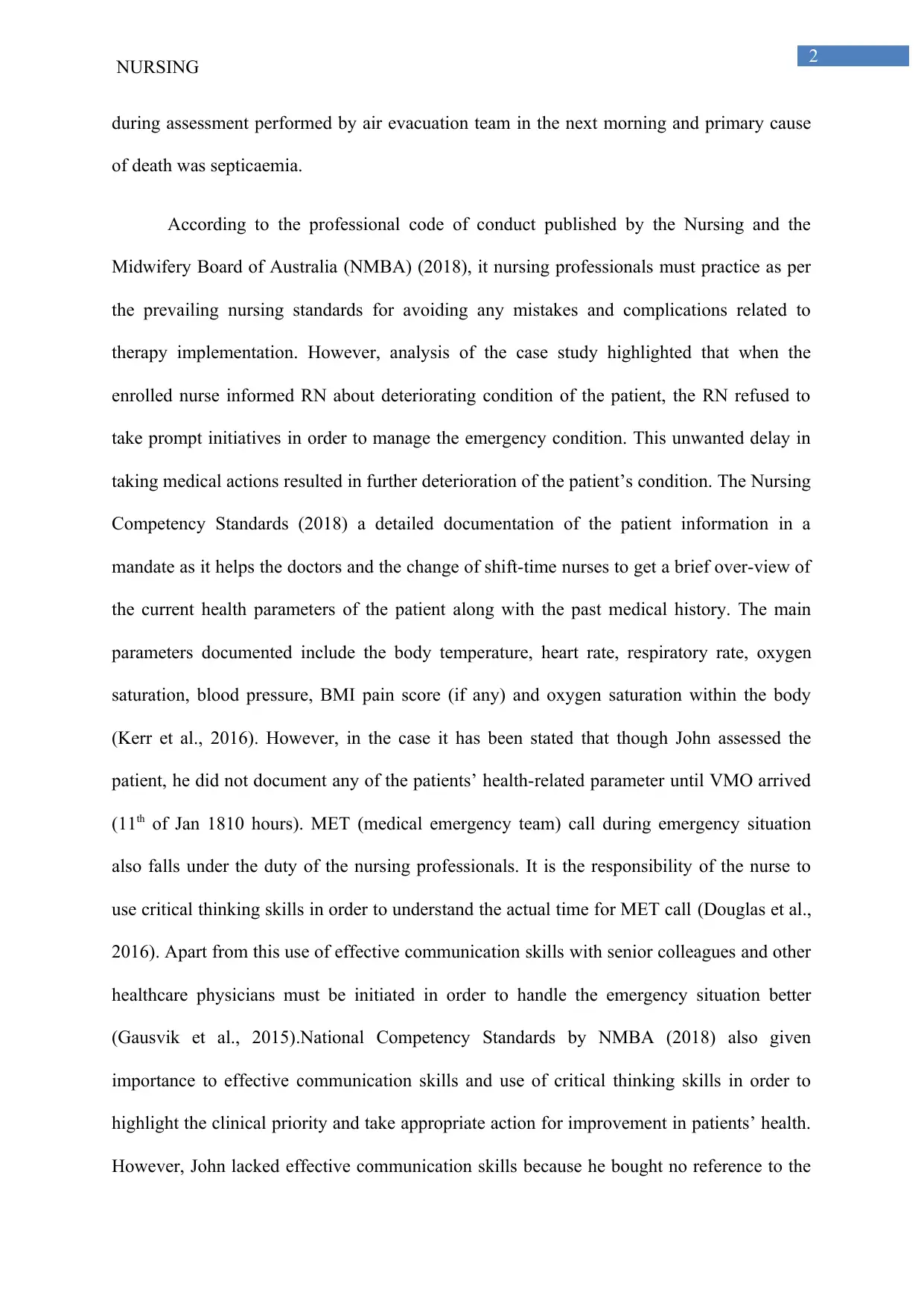
2
NURSING
during assessment performed by air evacuation team in the next morning and primary cause
of death was septicaemia.
According to the professional code of conduct published by the Nursing and the
Midwifery Board of Australia (NMBA) (2018), it nursing professionals must practice as per
the prevailing nursing standards for avoiding any mistakes and complications related to
therapy implementation. However, analysis of the case study highlighted that when the
enrolled nurse informed RN about deteriorating condition of the patient, the RN refused to
take prompt initiatives in order to manage the emergency condition. This unwanted delay in
taking medical actions resulted in further deterioration of the patient’s condition. The Nursing
Competency Standards (2018) a detailed documentation of the patient information in a
mandate as it helps the doctors and the change of shift-time nurses to get a brief over-view of
the current health parameters of the patient along with the past medical history. The main
parameters documented include the body temperature, heart rate, respiratory rate, oxygen
saturation, blood pressure, BMI pain score (if any) and oxygen saturation within the body
(Kerr et al., 2016). However, in the case it has been stated that though John assessed the
patient, he did not document any of the patients’ health-related parameter until VMO arrived
(11th of Jan 1810 hours). MET (medical emergency team) call during emergency situation
also falls under the duty of the nursing professionals. It is the responsibility of the nurse to
use critical thinking skills in order to understand the actual time for MET call (Douglas et al.,
2016). Apart from this use of effective communication skills with senior colleagues and other
healthcare physicians must be initiated in order to handle the emergency situation better
(Gausvik et al., 2015).National Competency Standards by NMBA (2018) also given
importance to effective communication skills and use of critical thinking skills in order to
highlight the clinical priority and take appropriate action for improvement in patients’ health.
However, John lacked effective communication skills because he bought no reference to the
NURSING
during assessment performed by air evacuation team in the next morning and primary cause
of death was septicaemia.
According to the professional code of conduct published by the Nursing and the
Midwifery Board of Australia (NMBA) (2018), it nursing professionals must practice as per
the prevailing nursing standards for avoiding any mistakes and complications related to
therapy implementation. However, analysis of the case study highlighted that when the
enrolled nurse informed RN about deteriorating condition of the patient, the RN refused to
take prompt initiatives in order to manage the emergency condition. This unwanted delay in
taking medical actions resulted in further deterioration of the patient’s condition. The Nursing
Competency Standards (2018) a detailed documentation of the patient information in a
mandate as it helps the doctors and the change of shift-time nurses to get a brief over-view of
the current health parameters of the patient along with the past medical history. The main
parameters documented include the body temperature, heart rate, respiratory rate, oxygen
saturation, blood pressure, BMI pain score (if any) and oxygen saturation within the body
(Kerr et al., 2016). However, in the case it has been stated that though John assessed the
patient, he did not document any of the patients’ health-related parameter until VMO arrived
(11th of Jan 1810 hours). MET (medical emergency team) call during emergency situation
also falls under the duty of the nursing professionals. It is the responsibility of the nurse to
use critical thinking skills in order to understand the actual time for MET call (Douglas et al.,
2016). Apart from this use of effective communication skills with senior colleagues and other
healthcare physicians must be initiated in order to handle the emergency situation better
(Gausvik et al., 2015).National Competency Standards by NMBA (2018) also given
importance to effective communication skills and use of critical thinking skills in order to
highlight the clinical priority and take appropriate action for improvement in patients’ health.
However, John lacked effective communication skills because he bought no reference to the
⊘ This is a preview!⊘
Do you want full access?
Subscribe today to unlock all pages.

Trusted by 1+ million students worldwide
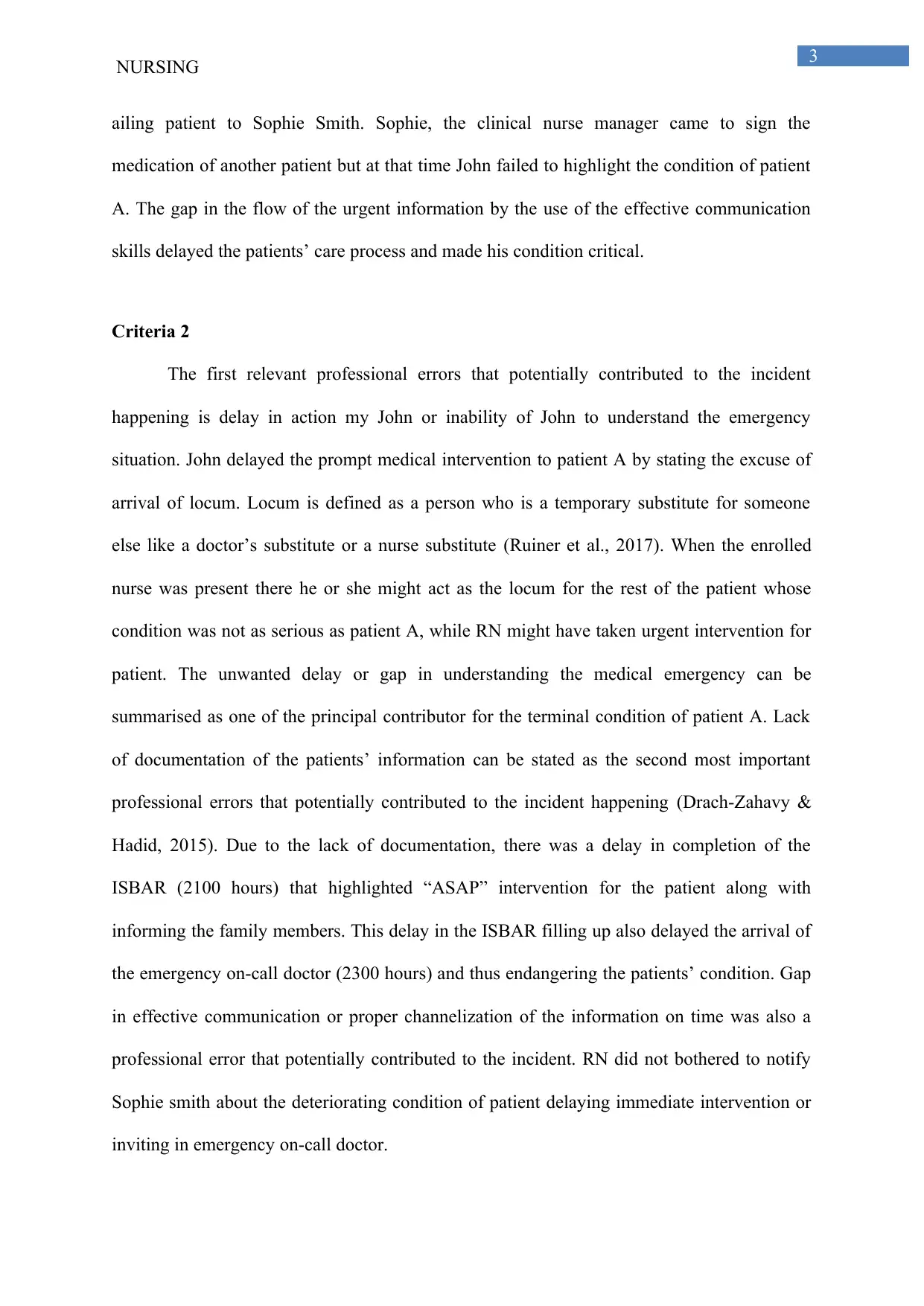
3
NURSING
ailing patient to Sophie Smith. Sophie, the clinical nurse manager came to sign the
medication of another patient but at that time John failed to highlight the condition of patient
A. The gap in the flow of the urgent information by the use of the effective communication
skills delayed the patients’ care process and made his condition critical.
Criteria 2
The first relevant professional errors that potentially contributed to the incident
happening is delay in action my John or inability of John to understand the emergency
situation. John delayed the prompt medical intervention to patient A by stating the excuse of
arrival of locum. Locum is defined as a person who is a temporary substitute for someone
else like a doctor’s substitute or a nurse substitute (Ruiner et al., 2017). When the enrolled
nurse was present there he or she might act as the locum for the rest of the patient whose
condition was not as serious as patient A, while RN might have taken urgent intervention for
patient. The unwanted delay or gap in understanding the medical emergency can be
summarised as one of the principal contributor for the terminal condition of patient A. Lack
of documentation of the patients’ information can be stated as the second most important
professional errors that potentially contributed to the incident happening (Drach‐Zahavy &
Hadid, 2015). Due to the lack of documentation, there was a delay in completion of the
ISBAR (2100 hours) that highlighted “ASAP” intervention for the patient along with
informing the family members. This delay in the ISBAR filling up also delayed the arrival of
the emergency on-call doctor (2300 hours) and thus endangering the patients’ condition. Gap
in effective communication or proper channelization of the information on time was also a
professional error that potentially contributed to the incident. RN did not bothered to notify
Sophie smith about the deteriorating condition of patient delaying immediate intervention or
inviting in emergency on-call doctor.
NURSING
ailing patient to Sophie Smith. Sophie, the clinical nurse manager came to sign the
medication of another patient but at that time John failed to highlight the condition of patient
A. The gap in the flow of the urgent information by the use of the effective communication
skills delayed the patients’ care process and made his condition critical.
Criteria 2
The first relevant professional errors that potentially contributed to the incident
happening is delay in action my John or inability of John to understand the emergency
situation. John delayed the prompt medical intervention to patient A by stating the excuse of
arrival of locum. Locum is defined as a person who is a temporary substitute for someone
else like a doctor’s substitute or a nurse substitute (Ruiner et al., 2017). When the enrolled
nurse was present there he or she might act as the locum for the rest of the patient whose
condition was not as serious as patient A, while RN might have taken urgent intervention for
patient. The unwanted delay or gap in understanding the medical emergency can be
summarised as one of the principal contributor for the terminal condition of patient A. Lack
of documentation of the patients’ information can be stated as the second most important
professional errors that potentially contributed to the incident happening (Drach‐Zahavy &
Hadid, 2015). Due to the lack of documentation, there was a delay in completion of the
ISBAR (2100 hours) that highlighted “ASAP” intervention for the patient along with
informing the family members. This delay in the ISBAR filling up also delayed the arrival of
the emergency on-call doctor (2300 hours) and thus endangering the patients’ condition. Gap
in effective communication or proper channelization of the information on time was also a
professional error that potentially contributed to the incident. RN did not bothered to notify
Sophie smith about the deteriorating condition of patient delaying immediate intervention or
inviting in emergency on-call doctor.
Paraphrase This Document
Need a fresh take? Get an instant paraphrase of this document with our AI Paraphraser
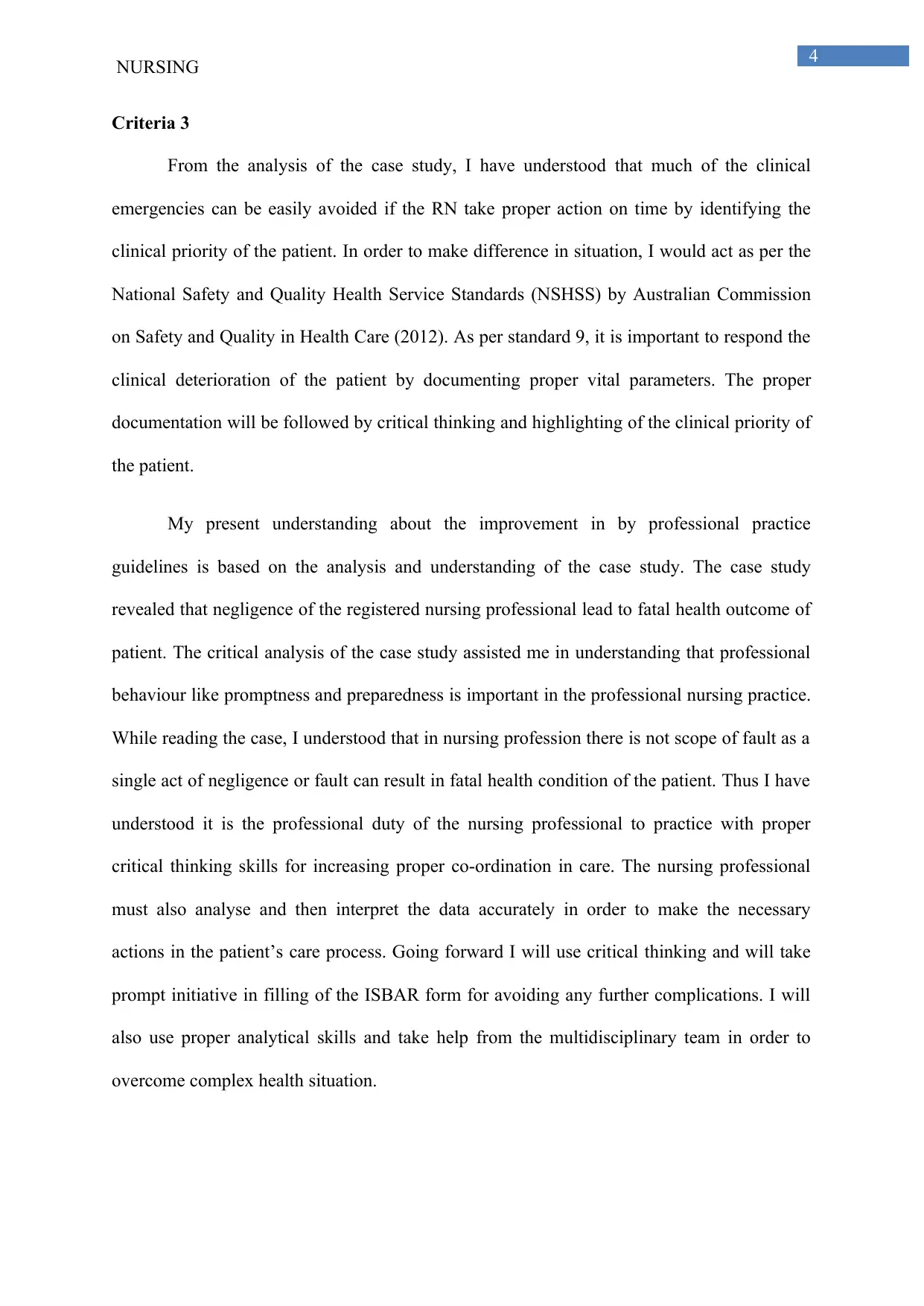
4
NURSING
Criteria 3
From the analysis of the case study, I have understood that much of the clinical
emergencies can be easily avoided if the RN take proper action on time by identifying the
clinical priority of the patient. In order to make difference in situation, I would act as per the
National Safety and Quality Health Service Standards (NSHSS) by Australian Commission
on Safety and Quality in Health Care (2012). As per standard 9, it is important to respond the
clinical deterioration of the patient by documenting proper vital parameters. The proper
documentation will be followed by critical thinking and highlighting of the clinical priority of
the patient.
My present understanding about the improvement in by professional practice
guidelines is based on the analysis and understanding of the case study. The case study
revealed that negligence of the registered nursing professional lead to fatal health outcome of
patient. The critical analysis of the case study assisted me in understanding that professional
behaviour like promptness and preparedness is important in the professional nursing practice.
While reading the case, I understood that in nursing profession there is not scope of fault as a
single act of negligence or fault can result in fatal health condition of the patient. Thus I have
understood it is the professional duty of the nursing professional to practice with proper
critical thinking skills for increasing proper co-ordination in care. The nursing professional
must also analyse and then interpret the data accurately in order to make the necessary
actions in the patient’s care process. Going forward I will use critical thinking and will take
prompt initiative in filling of the ISBAR form for avoiding any further complications. I will
also use proper analytical skills and take help from the multidisciplinary team in order to
overcome complex health situation.
NURSING
Criteria 3
From the analysis of the case study, I have understood that much of the clinical
emergencies can be easily avoided if the RN take proper action on time by identifying the
clinical priority of the patient. In order to make difference in situation, I would act as per the
National Safety and Quality Health Service Standards (NSHSS) by Australian Commission
on Safety and Quality in Health Care (2012). As per standard 9, it is important to respond the
clinical deterioration of the patient by documenting proper vital parameters. The proper
documentation will be followed by critical thinking and highlighting of the clinical priority of
the patient.
My present understanding about the improvement in by professional practice
guidelines is based on the analysis and understanding of the case study. The case study
revealed that negligence of the registered nursing professional lead to fatal health outcome of
patient. The critical analysis of the case study assisted me in understanding that professional
behaviour like promptness and preparedness is important in the professional nursing practice.
While reading the case, I understood that in nursing profession there is not scope of fault as a
single act of negligence or fault can result in fatal health condition of the patient. Thus I have
understood it is the professional duty of the nursing professional to practice with proper
critical thinking skills for increasing proper co-ordination in care. The nursing professional
must also analyse and then interpret the data accurately in order to make the necessary
actions in the patient’s care process. Going forward I will use critical thinking and will take
prompt initiative in filling of the ISBAR form for avoiding any further complications. I will
also use proper analytical skills and take help from the multidisciplinary team in order to
overcome complex health situation.
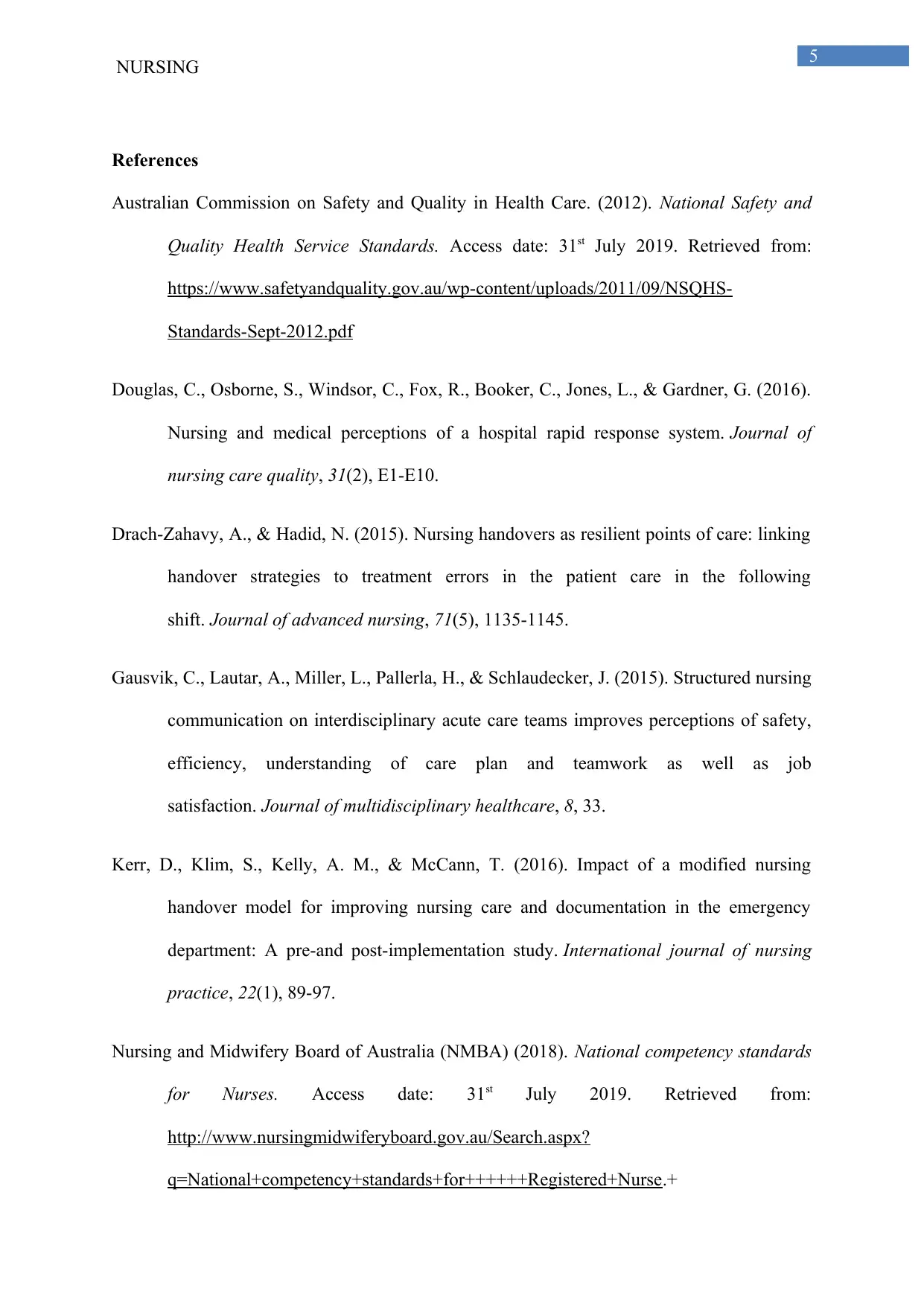
5
NURSING
References
Australian Commission on Safety and Quality in Health Care. (2012). National Safety and
Quality Health Service Standards. Access date: 31st July 2019. Retrieved from:
https://www.safetyandquality.gov.au/wp-content/uploads/2011/09/NSQHS-
Standards-Sept-2012.pdf
Douglas, C., Osborne, S., Windsor, C., Fox, R., Booker, C., Jones, L., & Gardner, G. (2016).
Nursing and medical perceptions of a hospital rapid response system. Journal of
nursing care quality, 31(2), E1-E10.
Drach‐Zahavy, A., & Hadid, N. (2015). Nursing handovers as resilient points of care: linking
handover strategies to treatment errors in the patient care in the following
shift. Journal of advanced nursing, 71(5), 1135-1145.
Gausvik, C., Lautar, A., Miller, L., Pallerla, H., & Schlaudecker, J. (2015). Structured nursing
communication on interdisciplinary acute care teams improves perceptions of safety,
efficiency, understanding of care plan and teamwork as well as job
satisfaction. Journal of multidisciplinary healthcare, 8, 33.
Kerr, D., Klim, S., Kelly, A. M., & McCann, T. (2016). Impact of a modified nursing
handover model for improving nursing care and documentation in the emergency
department: A pre‐and post‐implementation study. International journal of nursing
practice, 22(1), 89-97.
Nursing and Midwifery Board of Australia (NMBA) (2018). National competency standards
for Nurses. Access date: 31st July 2019. Retrieved from:
http://www.nursingmidwiferyboard.gov.au/Search.aspx?
q=National+competency+standards+for++++++Registered+Nurse.+
NURSING
References
Australian Commission on Safety and Quality in Health Care. (2012). National Safety and
Quality Health Service Standards. Access date: 31st July 2019. Retrieved from:
https://www.safetyandquality.gov.au/wp-content/uploads/2011/09/NSQHS-
Standards-Sept-2012.pdf
Douglas, C., Osborne, S., Windsor, C., Fox, R., Booker, C., Jones, L., & Gardner, G. (2016).
Nursing and medical perceptions of a hospital rapid response system. Journal of
nursing care quality, 31(2), E1-E10.
Drach‐Zahavy, A., & Hadid, N. (2015). Nursing handovers as resilient points of care: linking
handover strategies to treatment errors in the patient care in the following
shift. Journal of advanced nursing, 71(5), 1135-1145.
Gausvik, C., Lautar, A., Miller, L., Pallerla, H., & Schlaudecker, J. (2015). Structured nursing
communication on interdisciplinary acute care teams improves perceptions of safety,
efficiency, understanding of care plan and teamwork as well as job
satisfaction. Journal of multidisciplinary healthcare, 8, 33.
Kerr, D., Klim, S., Kelly, A. M., & McCann, T. (2016). Impact of a modified nursing
handover model for improving nursing care and documentation in the emergency
department: A pre‐and post‐implementation study. International journal of nursing
practice, 22(1), 89-97.
Nursing and Midwifery Board of Australia (NMBA) (2018). National competency standards
for Nurses. Access date: 31st July 2019. Retrieved from:
http://www.nursingmidwiferyboard.gov.au/Search.aspx?
q=National+competency+standards+for++++++Registered+Nurse.+
⊘ This is a preview!⊘
Do you want full access?
Subscribe today to unlock all pages.

Trusted by 1+ million students worldwide
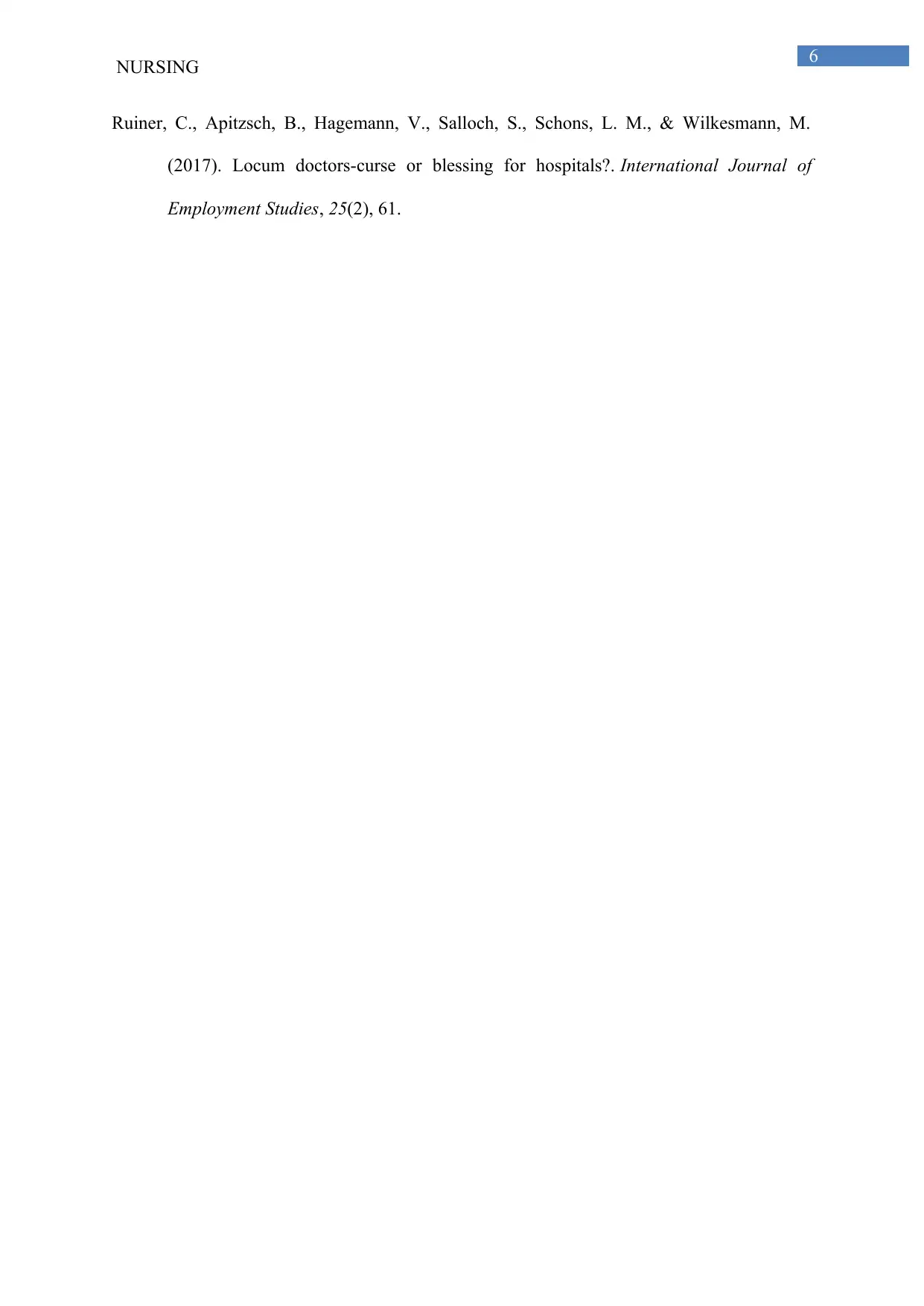
6
NURSING
Ruiner, C., Apitzsch, B., Hagemann, V., Salloch, S., Schons, L. M., & Wilkesmann, M.
(2017). Locum doctors-curse or blessing for hospitals?. International Journal of
Employment Studies, 25(2), 61.
NURSING
Ruiner, C., Apitzsch, B., Hagemann, V., Salloch, S., Schons, L. M., & Wilkesmann, M.
(2017). Locum doctors-curse or blessing for hospitals?. International Journal of
Employment Studies, 25(2), 61.
1 out of 7
Related Documents
Your All-in-One AI-Powered Toolkit for Academic Success.
+13062052269
info@desklib.com
Available 24*7 on WhatsApp / Email
![[object Object]](/_next/static/media/star-bottom.7253800d.svg)
Unlock your academic potential
Copyright © 2020–2025 A2Z Services. All Rights Reserved. Developed and managed by ZUCOL.




